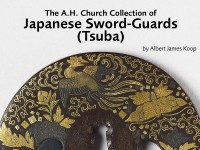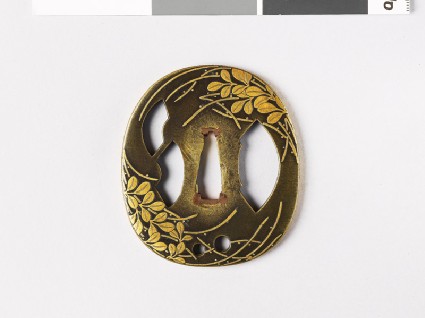The A. H. Church Collection of Japanese Sword-Guards (Tsuba)
An unpublished catalogue of the A. H. Church collection of Japanese sword-guards (tsuba) by Albert James Koop.

Publications online: 1264 objects
Tsuba with aoi, or hollyhock leaves, and foliage
-
Literature notes
Decorated in rich gold nunome with fine engraving finish, the cross-hatching covering the rest of the ground; on the front, 22 heraldic aoi leaves connected in four groups by tendrilled stems; on the back, two bold realistic sprays of lespedeza foliae and grasses with dewdrops; edge gilt; kodzuka and kōgai holes of folding fan mount shape, the former of extra large size, the latter with a somewhat smaller one near it; udenuki holes. -
Details
- Associated place
- Date
- 18th century (1701 - 1800)
- Material and technique
- sentoku, with engraved gold nunome-zōgan decoration; tang-hole plugged with soft metal, probably copper
- Dimensions
- 7.7 x 6.8 cm (height x width)
- Material index
-
processed material › metal › alloy › sentoku,processed material › metal › gold,
- Technique index
- Object type index
-
arms/armour › koshirae › kodogu › tsuba
- No. of items
- 1
- Credit line
- Bequeathed by Sir Arthur H. Church, 1915.
- Accession no.
- EAX.10852
-
Further reading
Koop, Albert James, The A. H. Church Collection of Japanese Sword-Guards (Tsuba), 3 vols (Oxford, Ashmolean Museum, 1929), no. 852
Glossary (3)
nunome-zōgan, sentoku, tsuba
-
nunome-zōgan
Decorative application of metal sheeting (generally of gold or silver) where the iron ground is first cross-hatched and the metal burnished on.
-
sentoku
A kind of brass made from an alloy of copper, zinc, and tin.
-
tsuba
Japanese sword guard.
Location
-
- currently in research collection
Objects are sometimes moved to a different location. Our object location data is usually updated on a monthly basis. Contact the Jameel Study Centre if you are planning to visit the museum to see a particular object on display, or would like to arrange an appointment to see an object in our reserve collections.
Publications online
-

The A. H. Church Collection of Japanese Sword-Guards (Tsuba)
Decorated in rich gold nunome with fine engraving finish, the cross-hatching covering the rest of the ground; on the front, 22 heraldic aoi leaves connected in four groups by tendrilled stems; on the back, two bold realistic sprays of lespedeza foliae and grasses with dewdrops; edge gilt; kodzuka and kōgai holes of folding fan mount shape, the former of extra large size, the latter with a somewhat smaller one near it; udenuki holes.
Notice
Object information may not accurately reflect the actual contents of the original publication, since our online objects contain current information held in our collections database. Click on 'buy this publication' to purchase printed versions of our online publications, where available, or contact the Jameel Study Centre to arrange access to books on our collections that are now out of print.
© 2013 University of Oxford - Ashmolean Museum

